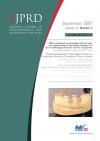European Journal of Prosthodontics and Restorative Dentistry
Effect of selected mouthwashes with and without toothbrushing on the surface hardness of a resin modiï¬ed glass-ionomer and two compomers.
Abstract
Abstract - Objectives. Physical properties of some restorative dental materials can change as a result of exposure to mouthwashes and toothbrushing. The purpose of this laboratory study was to investigate the possible effects of three commercially available mouthwashes on the surface hardness and weight of a resin modiï¬ed glass-ionomer and two compomers when used with and without tooth brushing. Methods. Specimens of the restorative materials in the study (Vitremer, Compoglass and Dyract) were prepared. Half of the specimens were only exposed to a mouthwash (Plax, Macleans, Listerine, Corsodyl or deionised water as control). The remaining specimens were exposed to one of the mouthwashes in conjunction with tooth brushing. The initial surface hardness and the surface hardness after 24 weeks were assessed using a Wallace hardness testing instrument. The specimens were assessed for possible weight changes between baseline and 24 weeks using a digital balance. Results. Mouthwash only: The Wallace hardness values of Vitremer and Compoglass increased in all groups. For Vitremer the increase was signiï¬cantly higher in Macleans group in comparison with the control, Listerine and Corsodyl groups (P<0.05). For Compoglass the increase in Plax and Macleans groups were signiï¬cantly higher compared with the control group (P<0.05). Dyract specimens revealed an increase in Wallace hardness values in all test groups whilst the control group revealed a decrease (P<0.05 except for Plax). Mouthwash and toothbrushing. Wallace hardness for all materials increased. The difference was not signiï¬cant between groups (P>0.05). Weighing the specimens of Vitremer revealed that after 24 weeks exposure to mouthwash and toothbrushing some groups had lost weight while an increase in weight was observed in others (P>0.05). For Compoglass and Dyract, all groups had lost weight after 24 weeks (P>0.05). Signiï¬cance. Exposure of the materials investigated in this study to the mouthwashes and toothbrushing had adverse effects on surface hardness. The adverse effects were more apparent when the mouthwashes were used alone.
KEY WORDS: Mouthwash; Toothbrushing; Tooth-coloured restorative materials; Surface hardness
Authors
Leili Sadaghiani, Margaret A. Wilson, Nairn H.F. Wilson
Articles from this issue
 Free Access
Free Access No Access
No Access Full Access
Full Access


